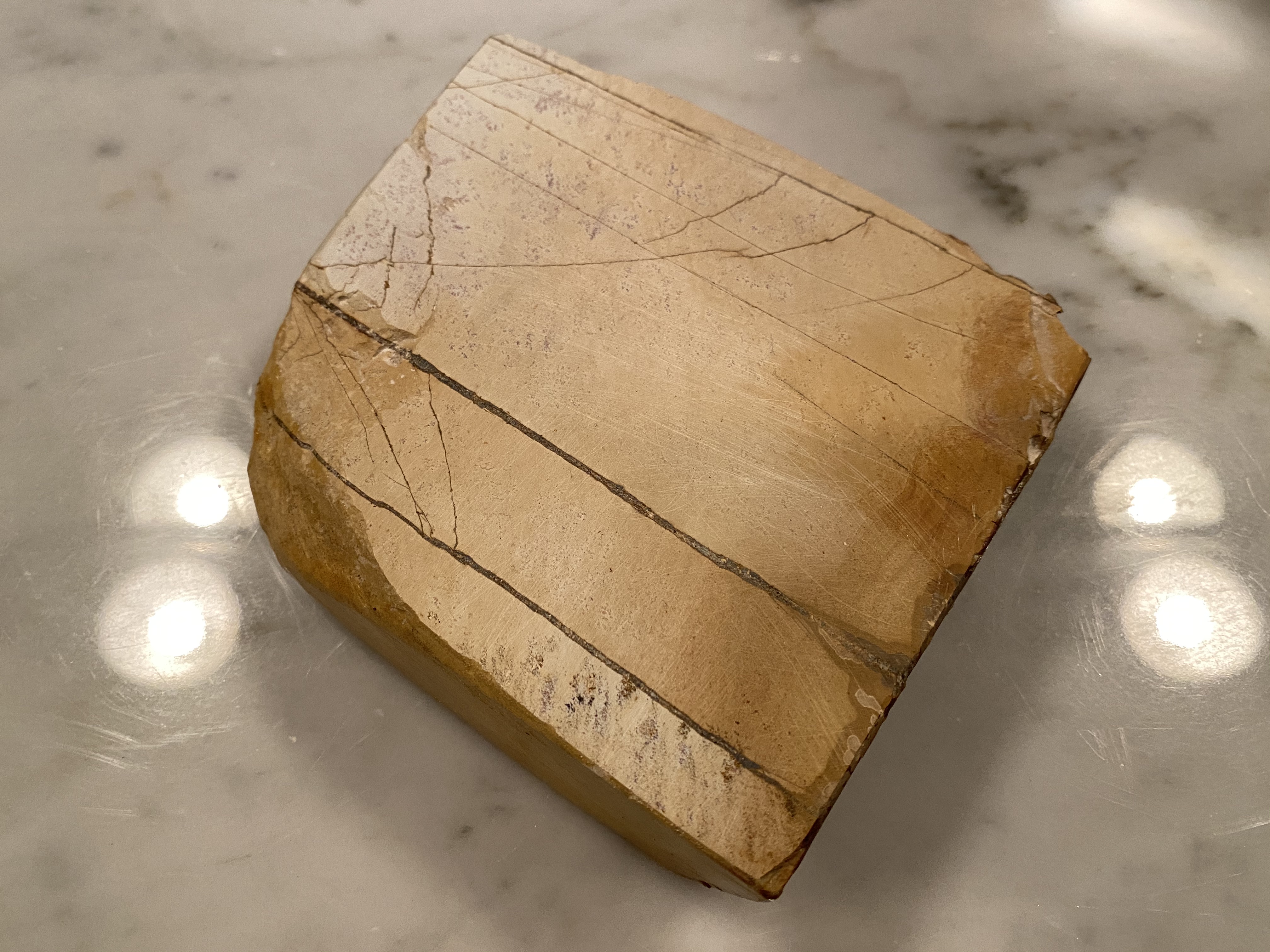
Vintage from the 1980s
Materials
Stone, Lacquer
Description
This stone is a piece of art! I have said it before, but Suita is still my favorite type of JNAT. This particular one does not disappoint. At just over one kilogram, this stone will out live you for sure. I love its shape - very natural and rustic. Plenty of kawa on it, as well as beautiful Pink Renge!
This is a hard stone. It is also fine enough to finish your straight razor. The shave from this stone is comfortable. It can also be used as an excellent pre-finisher for your Awasedo. It has normal cutting speed. It is smooth, yet grainy with its own slurry, and like smooth chalk with just water. It is a pretty easy stone to use. Seasoned honers and beginners will love this Suita! The bottom and sides have been sealed with lacquer.
This stone comes with a matching Tomo Nagura.
This stone comes lapped and chamfered, and can be used as is. However, depending on personal preference, you can lap it some more.
Dimensions:
Whetstone (Max)
140mm x 122mm x 30mm
1,025gTomo Nagura
66gWhat is it?
This is a sharpening stone, for use to sharpen a variety of blades. It is utilized by spritzing water on the top. Then you swipe your blade across the top face, back and forth. With most blades, you swipe with the blade facing forward at just a slight acute angle, like you are trying to slice a piece of the stone off - but do not slice off a piece. Razors and chisel type blades should be completely flat on the stone while you are sharpening. When you get the hang of it, you can try other patterns like x-strokes, circles, one step forward and half a step backward, etc. Practice makes perfect. This stone will benefit with the use of a nagura (slurry stone).
What will you get?
You will receive only the large white-ish stone and small nagura (slurry stone) in the photos; the exact item in the photos.
What about care?
This stone was mined from a mountain, obviously. Therefore, cool temperatures to room temperature will be just fine. If it was out in 100+ degree weather (Fahrenheit) long enough to soak up that heat, I would bring it into the shade and wait until it has cooled off a bit before you wet it. The same applies if it was in below freezing temperatures. This is because there is a very small chance (but a chance nonetheless) of the stone cracking due to abrupt temperature changes. It is not just this stone - that goes with any and all sharpening stones. Also keep it away from any oil. If your hands are oily, wash them before use. Water is the only medium you should use on this stone.
Is it for you?
Natural whetstones are for people who want to enjoy a natural way of sharpening blades. It is for you if you like the idea that you are using the same type of stones that other people used hundreds of years ago. Another cool aspect is that this stone was mined from nature, and took hundreds of millions of years to form, meaning there will be similar looking stones, but never identical. These stones are one of a kind. It is also for you if you are looking to change it up a bit! New experiences are key to excitement. The cutting action of the blade feels slightly different when it is sharpened on naturals. Most grow to prefer the feel. It is a sensation that cannot be explained, only experienced. If you are already a seasoned JNATS user, then you already know that variety is key as well. You may have a finisher, but do you have a coarser, beginner's stone? If you have a course stone, do you have a finisher? Do you have any in-between stones? If you are not progressively removing the fine scratches on your blade caused by the previous stone, and skip to a much finer stone, then you are just polishing those scratches instead of removing them - which helps a little, but not entirely. Those deeper scratches need to be removed completely and replaced progressively with shallower scratches. The shallower the scratch pattern on your cutting edge, the more keen it is, and the more comfortable the cut. If you have been bitten by the JNATS bug (guilty as charged...) and need more for your collection, then this is definitely for you! Most natural stones also last longer than synthetic stones. If you own a decent sized stone, it will last longer than you will. This makes it: A - a good investment. B - An heirloom that can be passed down. Once you have learned to sharpen with naturals, you will have a cutting edge superior to any you have had before, and feel like a true sharpening pro, akin to those that have come before you long ago.
What do the words mean?Hideriyama - The mine it is from
Suita - The type of stone
Renge - This is the pattern, and it is exclusive to suita stones, it refers to the fine colorful lines and small spots on the stone